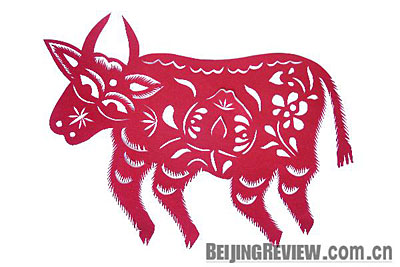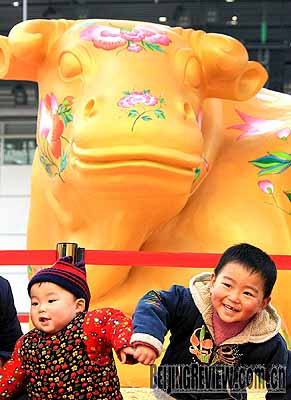|
 |
|
BULLISH CUT: Paper-cut ox is one of the popular decorations in the houses of Chinese during this year's Spring Festival (CFP) |
According to the Chinese lunar calendar, every year corresponds to an animal, and there are 12 animals-rat, ox, tiger, rabbit, dragon, snake, horse, sheep, monkey, rooster, dog and pig-which make up the zodiacs to symbolize different years. The year 2009 is the Year of Niu (Ox).
Importance of the ox
In the sequence of the 12 animal signs, ox ranks second. Ox is one of the favorite animals of the Chinese, and many have a special sentiment for it as, in their eyes, the animal represents industriousness and being upright.
 |
|
CELEBRATION: Two boys play near the huge ox sculpture put in Nanjing Road, Shanghai, welcoming the Year of the Ox (CHEN FEI) | Ox is also the representative of the farming culture of China. The Chinese civilization has its roots in the development of agriculture. In the farming economy with its autarkic operation, oxen are the major draught animals hauling plows. An old Chinese saying goes that oxen were the lifeline of the farmers.
Of course, the good of oxen is not limited to plowing. Actually, the whole body of an ox is full of treasures. They are also seen as "boats on land" for their capability to carry loads, and their meat and milk are nourishing food. The skin of oxen can be used to make clothes, shoes and hats and the hair can be twisted into ropes or rolled into felt carpets. Apart from this, oxen excrement can be used as fuel. With all these attributes, oxen are viewed as generous creatures. Today, oxen can still be found to haul plows across the fields of villages in China's hinterland.
In the past, oxen played an important role in the spiritual life of the Chinese. They are important and indispensable in various ceremonial occasions such as sacrifices, feasts, weddings or funerals. Even today, oxen play an important role in some folk activities. For example, people of the Pumi ethnic group who live in southwest China's Yunnan Province will cook cattle bone soup and share it among family members and relatives when holding the right-of-passage ceremony for children who reach 13. The Pumi people believe that the cattle bone soup symbolizes the blood relationship and cohesion among family members and the unity and prosperity of the family.
Because of the contribution of oxen and the important role oxen have played in their lives, the Chinese people feel deeply indebted to the animal. In addition, the use of oxen in rituals and the thanks people feel to oxen helped develop various conventional customs, which becomes an important part of the folk culture of the Chinese nation.
There are a lot of poems or tales in China that praise oxen, most of which depict them as creatures that are accommodating and value friendship and affection. In the widely known tale about Niulang (cowherd) and Zhinu (weaving maid)), the ox is generous and loyal to its owner, Niulang. In the tale, the ox not only informs Niulang of the coming of Zhinu, a fairy in the heavenly palace, but also manages to help Niulang marry Zhinu. Finally, in order to help Niulang to meet Zhinu, who has been torn apart by the Milky Way from Niulang, the ox sacrifices its skin to its owner. By taking on the skin, Niulang gets the capability to fly to the heaven and see his wife in the sky.
In some Chinese myths, oxen are deified as creator of the universe. For example, an epic story comes down from generations in some areas in Yunnan Province inhabited by the Hani ethnic people, in which an ox is depicted as the deity of nature. According to the story, the sun is made of the left eye of the ox, the moon the right eye of the ox and the land the flesh, while terraces are made of the ribs, stars the teeth, rivers the blood, rains the tears, and trees, flowers and other plants are made of the animal's hair. In other words, everything in nature evolves from the body of the divine ox or things related with it, which embodies man's respect and worship to the animal.
|
